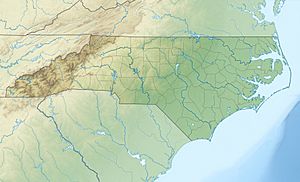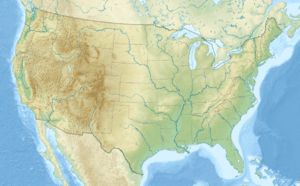Duncombe Creek (Uwharrie River tributary) facts for kids
Quick facts for kids Duncombe Creek |
|
|---|---|
|
Location of Duncombe Creek mouth
|
|
| Other name(s) | Tributary to Uwharrie River |
| Country | United States |
| State | North Carolina |
| County | Randolph Montgomery |
| Physical characteristics | |
| Main source | Poison Fork divide east side of King Mountain 830 ft (250 m) 35°27′14″N 080°00′18″W / 35.45389°N 80.00500°W |
| River mouth | Uwharrie River about 4 miles south-southeast of Coggins Mine 315 ft (96 m) 35°31′01″N 079°57′06″W / 35.51694°N 79.95167°W |
| Length | 5.59 mi (9.00 km) |
| Basin features | |
| Progression | southwest |
| River system | Pee Dee |
| Basin size | 4.29 square miles (11.1 km2) |
| Tributaries |
|
| Bridges | Grissom Road, Ophir Road |
Duncombe Creek is a small stream, about 5.59 mi (9.00 km) long. It flows into the Uwharrie River in Montgomery County, North Carolina. It's known as a "1st order tributary," which means it's one of the smallest streams that doesn't have other named streams flowing into it.
Where Does Duncombe Creek Flow?
Duncombe Creek starts in Randolph County, North Carolina, on the east side of King Mountain. It begins near a place called the Poison Fork divide.
From there, the creek flows towards the southwest. It travels for about 5.59 miles before it joins the Uwharrie River. This meeting point is about 4 miles south-southeast of a place called Coggins Mine.
What is Duncombe Creek's Watershed Like?
A watershed is like a big bowl where all the rain and water drain into a specific river or creek. Duncombe Creek's watershed covers an area of about 4.29 square miles (11.1 km2).
Each year, this area gets about 47.5 inches of rain. A large part of the land around the creek, about 79%, is covered by forests. This helps keep the water clean and healthy for local wildlife.



